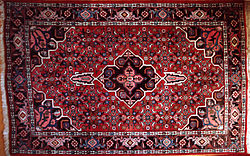Bijar
| Bijar بيجار |
|
|---|---|
 |
|
| Location in Iran | |
| Coordinates: 35°52′22″N 47°36′10″E / 35.87278°N 47.60278°ECoordinates: 35°52′22″N 47°36′10″E / 35.87278°N 47.60278°E | |
| Country |
|
| Province | Kurdistan |
| County | Bijar |
| Bakhsh | Central |
| Population (2011) | |
| • Total | 47,926 |
Bījār (Persian: بیجار; Central Kurdish: بیجاڕ,Kurdish: Bîcar) is a city in and capital of Bijar County, Kurdistan Province, Iran. At the 2011 census, its population was 47,926, in 14,970 families. With an elevation of 1,940 metres, Bijar is called the Roof of Iran.
Bijar is known internationally for its elegant and ancient carpet and rug designs. The term bijar could be a variation of bajar (i.e. city in Kurdish) and the complete name of the city is Bijar-e Garrus (city of Garrus). Among other suggested etymology for bijar are bid-zar (land of willow tree) which is linguistically unlikely.
Historically, Bijar has been part of Garrus administration unit. Before the creation of Zanjan province by the Pahlavi regime (after WWI), the wider region of Garrus covered Suhreward, the birthplace of Shahab al-Din Suhrewardi, the famous Persian philosopher of illumination.
The city was mentioned in the 15th century as a village belonging to Shah Ismail the first ruler of the Safavid dynasty, Bijar became a town during the 19th century. During World War I it was besieged and occupied by Russian, British, and Ottoman troops.
The historical fort of Qam Cheqay in valley of kings (45 km of Bijar) probably dates back to the Median era and it is the oldest castle in the Kurdistan province. The castle has been used until the Sasanid era and it is an example of ancient architecture of Kurdistan.
Another historical building, Emamzadeh Aqil, located in Hasan Abad (Yasukand) 45 km east of Bijar is one of the remaining Saljugi buildings. The square building (6*6.5 m) with the collapsed dome has been home to Islamic religious texts written in Kufi script.
Bijar's bazaar, with its unique design is one of the attractions of the city. The roofed bazaar built in the Qajar era is much younger than the Safavid era old bazaar of Sanadaj. The bazaar of Bijar consists of a main north-south roofed pathway and an eastern section (Timcheh-e Haj Shahbaz) and a western section (Timcheh-e Amir Toman).
...
Wikipedia

